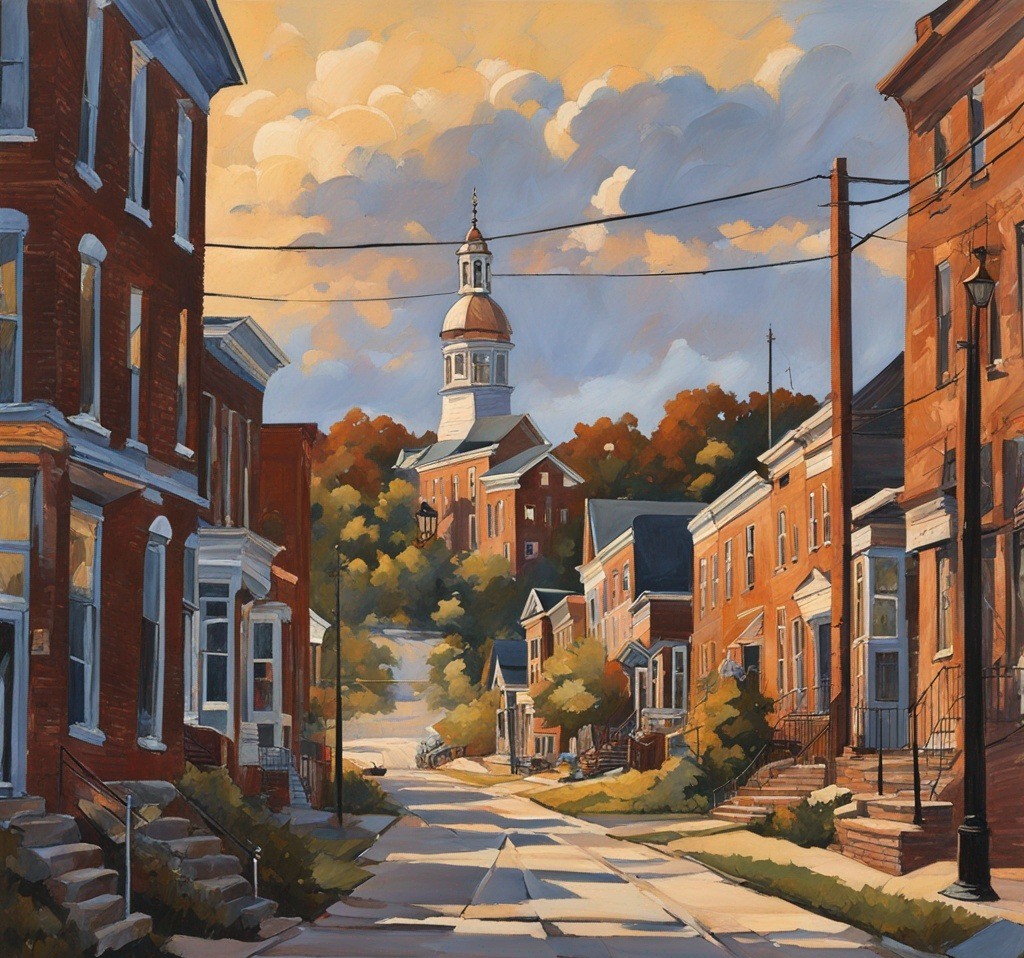The Golden Hour in Annapolis: When a Street Becomes a Time Capsule
There exists a magical moment each day when the late afternoon sun transforms ordinary places into extraordinary landscapes—when light becomes so tangible it seems to have texture and weight, when shadows stretch into elegant blue counterpoints to the golden radiance, and when even the most familiar scenes reveal new dimensions of beauty simply through the alchemy of perfect illumination.
ART
5/1/20256 min read


I discovered this particular street in Annapolis, Maryland quite by accident. Having wandered away from the more tourist-heavy areas near the harbor, I found myself in a residential neighborhood that seemed to exist in its own temporal dimension—a place where the 18th, 19th, and 21st centuries coexisted in architectural harmony.
The scene before me was breathtaking. A narrow street flanked by brick row houses in various shades of rust and sienna descended gently toward the town center, where the distinctive white dome of the Maryland State House rose above the surrounding buildings like a beacon of history. The late afternoon sun had transformed everything—brick facades glowed as if illuminated from within, white trim work around windows and doors stood in crisp relief against the warmer tones, and the slate rooftops reflected blue hints of the sky above.
What struck me immediately was the remarkable state of preservation. These weren't museum recreations but actual homes, maintained with historical accuracy yet clearly inhabited by modern residents. Electrical lines and the occasional parked car provided the only obvious concessions to contemporary life. Otherwise, the street appeared much as it might have 150 years ago—a living connection to America's colonial and federal periods.
The quality of light at that hour—what photographers and painters call the "golden hour"—enhanced the historical authenticity. Without the harsh shadows of midday, the street's features emerged with subtle dimensionality. Details that might otherwise go unnoticed became prominent: the varying patterns of brickwork indicating different construction periods, the gentle bow of original glass in older windows, the patina of well-worn stone steps leading to each front door.
I stood motionless for several minutes, absorbing the scene and watching how the changing angle of sunlight continuously altered the visual composition. The street itself became a canvas, with light painting shifting patterns as it filtered between buildings and through the branches of mature trees whose autumn foliage echoed the warm tones of the brick.
The most prominent feature anchoring the composition was the State House dome, its white surface turned golden by the low sun. Completed in 1788, it remains the oldest state capitol still in continuous legislative use. Having witnessed the ratification of the Treaty of Paris (formally ending the Revolutionary War) and temporarily served as the capital of the United States, this building represents a physical link to America's founding moments. From my vantage point on this residential street, the dome appeared perfectly framed between the converging lines of houses, creating a natural focal point that drew the eye through the scene.
As I lingered, absorbing the timeless quality of the view, a deeper understanding of the street emerged. This wasn't merely an aesthetically pleasing arrangement of historic architecture but a physical manifestation of how Americans have continued to inhabit their history. Unlike European cities where medieval streets might be preserved primarily for tourism, or modern developments where history is erased for convenience, this Annapolis neighborhood represented a more nuanced approach to temporal continuity.
The houses themselves told stories of evolution and adaptation. Originally built for merchants, sea captains, and government officials in the 18th and early 19th centuries, they had clearly experienced numerous renovations and updates through the decades. Yet these changes had been executed with remarkable sensitivity to the original architectural character. Modern infrastructure—plumbing, electricity, internet cables—had been incorporated without compromising historical integrity. The result was not fossilized history but living heritage.
I began walking slowly down the street, noticing how each house, while conforming to the general architectural vocabulary of Federal and Georgian styles, expressed individual character through subtle variations. Some featured decorative lintels above windows, others displayed more ornate cornices. Front doors ranged from simple to elaborate, with fanlight windows, sidelights, and varied hardware indicating different periods and personal preferences. These weren't houses built from identical plans but homes that had evolved organically, each accumulating its unique history.
The brick sidewalks beneath my feet had been worn smooth by countless footsteps over centuries. Uneven in places, with subtle undulations created by settling foundations and growing tree roots, they presented a subtle physical challenge that demanded attention to each step—a reminder that navigating history requires mindfulness.
As I descended the gentle slope toward the State House, I noticed aspects of the neighborhood's social character. Small front gardens, meticulously maintained despite their limited size, displayed both traditional and contemporary landscaping choices. Some residents had placed benches or chairs on their stoops, suggesting community interaction and public presence. Window boxes overflowed with seasonal flowers, expressing individual care within the collective historical setting.
Several doors displayed discreet plaques indicating the original construction date and sometimes the name of the first owner—1790, Capt. James Ridgely; 1805, Thomas Harrison, Merchant. These weren't merely historical annotations but expressions of connection and stewardship, acknowledging that current residents were simply the latest in a long procession of caretakers for these historic structures.
The quality of preservation in this neighborhood wasn't accidental but the result of deliberate policy and community commitment. Annapolis had implemented some of America's earliest historic preservation ordinances, recognizing that its architectural heritage represented not just local but national significance. The Historic Annapolis Foundation, established in the 1950s, had worked diligently to preserve the city's colonial character while accommodating modern life—a delicate balance achieved with remarkable success on this particular street.
As I reached the halfway point, I encountered a resident emerging from one of the homes—a woman in her sixties carrying a small watering can for her window boxes. "Beautiful evening," she commented, noticing my obvious appreciation of the surroundings.
"It's extraordinary," I replied. "Have you lived here long?"
"Going on thirty years," she said, "and I still notice something new about this street almost every day. The light's never quite the same twice."
This casual interaction reinforced my emerging understanding of the neighborhood. These weren't museum exhibits but homes where real life unfolded against an extraordinary historical backdrop. The residents weren't merely historical reenactors but people who had chosen to integrate their contemporary lives with architectural heritage.
"Is it challenging, maintaining a historic home?" I asked.
She laughed softly. "It's a labor of love. The regulations are strict—we can't change anything on the exterior without approval, and even interior modifications need to respect the original structure. Heating bills in winter would make you weep. But then there are moments like this—" she gestured toward the golden light illuminating the street, "—when it all seems worthwhile."
As our conversation concluded and I continued my exploration, I reflected on how this street represented something profound about the American relationship with history. Unlike European nations with longer architectural timelines or newer countries with less preserved heritage, America occupies a middle ground—old enough to have substantial history worth preserving but young enough that this preservation remains a conscious choice rather than an inevitable condition.
The light continued its subtle transformations as the sun descended further. Shadows lengthened across the brick pavement, creating diagonal patterns that emphasized the street's perspective. Windows began to glow from within as residents turned on lights against the approaching evening. The State House dome remained illuminated by direct sunlight even as the street fell into soft shadow, creating a dramatic contrast that emphasized its landmark status.
I realized that what made this scene so captivating wasn't just the historical architecture or the quality of light, but their intersection—the way the golden hour illumination revealed aspects of these buildings that remained hidden during other parts of the day. The low-angled sunlight emphasized textures, highlighted architectural details, and created a warmth that seemed to compress time, making the historical feel immediate and accessible.
As twilight approached, the street underwent another transformation. Gradually, historically appropriate street lamps—gas-style fixtures converted to electricity—began to illuminate, creating pools of warm light that maintained the historical ambiance while acknowledging contemporary requirements for safety and convenience. This thoughtful integration of modern necessity with historical aesthetics exemplified the street's overall approach to preservation.
The experience of this Annapolis street during golden hour offered more than aesthetic pleasure; it provided a model for how we might think about history more broadly—not as something separate from present experience but as a foundation that continues to shape and inform contemporary life. These buildings had witnessed the entire American experiment from its earliest days, hosting generations of residents through wars, depressions, technological revolutions, and social transformations. Yet they remained fundamentally what they had always been: homes where daily life unfolded, adapted to current needs while respecting original purpose.
As darkness finally settled and the full effect of the golden hour faded, I reluctantly prepared to leave this remarkable street. The experience had affected me more deeply than I had anticipated. Beyond the photogenic beauty that had initially captured my attention, I had glimpsed something profound about historical continuity and the ways physical spaces connect us to our collective past.
Walking back toward the more commercial areas of Annapolis, I carried with me not just visual memories but a deeper appreciation for places where history isn't cordoned off as a separate experience but integrated into everyday life—where the past isn't preserved in amber but maintained as a living context for continuing human experience. And I marveled at how the simple magic of perfect afternoon light had revealed these deeper truths, transforming a chance encounter with a historic street into a meaningful meditation on time, place, and the continuing American conversation between past and present.
Get in touch


